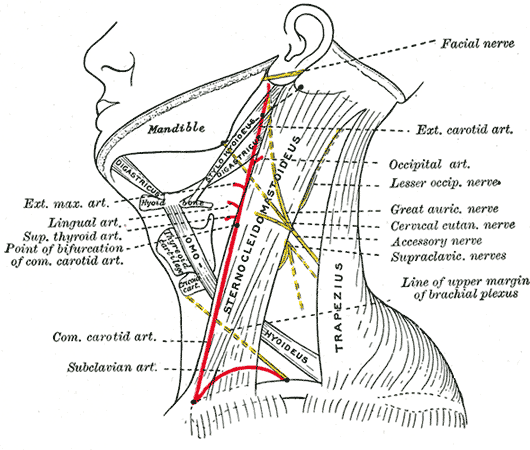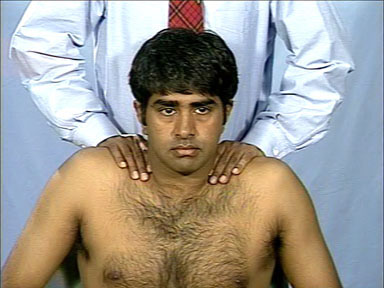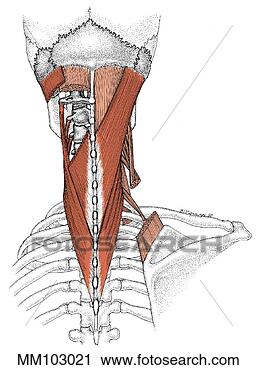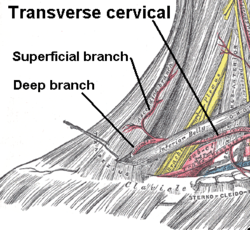The neck is divided into
- anterior triangle and
- posterior triangle
by sternocleidomastoid.

POSTERIOR TRIANGLE
It is the space located behind the sternocleidomastoid.

BOUNDARIES
Anterior: posterior border of sternocleidomastoid.
Posterior: anterior border of trapezius.
Apex: meeting point of the above muscles.
Roof:
- skin
- superficial fascia
- investing layer of deep cervical fascia
- platysma.
Floor:
- splenius capitis
- levator scapulae
- scalenus anterior
- scalenus medius and
- scalenus posterior.
1. TRAPEZIUS
Origin:
- medial 1/3 of the superior nuchal line,
- external occipital protuberance
- ligamentum nuchae
- C7 -C12 spine.

Insertion:
- upper fibres is inserted into posterior border of lateral 1/3 of the clavicle.
- middle fibres is inserted into acromian process and upper lip of the crest of the spine of the scapula.
- lower fibres is inserted into the deltoid tubercle.
Nerve supply:
motor nerve supply: spinal part of accessory nerve.
sensory nerve supply: C3,C4.
Actions:
upper fibre: elevates the scapula.
middle fibre: retract the scapula.
both act together and helps in the abduction of the arm beyond 90 degree.
Tests:
Apply pressure on the shoulder from the back and ask him to raise the shoulder.If he is able to raise then he is the normal person.If the trapezius is paralysed then the person is unable to raise the shoulder.There is the notable drooping of shoulder.

Structures under the cover of trapezius:
- semispinalis capitis
- splenius capitis
- levator scapulae
- inferior belly of omohyoid
- rhomboideus major
- rhomboideus minor
- supraspinatus
- infraspinatus
- lattismus dorsi and
- serratus posterior superior.
- suprascapular artery and vein
- transverse cervical artery
- spinal root of accessory nerve
- suprascapular nerve
- C2-C6 and T1-T12.
Development:
develops from the branchial arch mesoderm.
A. SEMISPINALIS CAPITIS
Origin:
It takes its origin from the C3-T4 vertebra.

Insertion:
It is inserted into the medial part of the area between the superior nuchal line and inferior nuchal line.
Nerve supply:
It is supplied by the dorsal ramus of the first and second cervical nerve.
Action:
Mainly postural.
B. SPLENIUS CAPITIS
Origin:
It takes its origin from the lower half of the ligamentum nuchae and also from the spinous process of the upper 6 thoracic vertebra.

Insertion:
It forms the floor of the suboccipital triangle and gets inserted into the mastoid process.
*SUBOCCIPITAL TRIANGLE:
It is the deeper space.
in order to expose suboccipital triangle,the following layers have to be exposed.
- skin
- superficial fascia containing the greater and third occipital nerve,occipital artery and veins.
- trapezius and sternocleidomastoid
- splenius capitis
- semispinalis capitis.
Boundaries:
Superomedially rectus capitis posterior major and rectus capitis posterior minor.
Superolaterally obliquus superior.
Inferiorly obliquus inferior.
* Rectus capitis posterior major:
Origin:
spine of axis
Insertion:
lateral part of the area below the inferior nuchal line.
Nerve supply:
suboccipital nerve.
Actions:
- mainly postural
- acting alone it turns the chin to the same side
- acting together the two muscles extend the head.
* Rectus capitis posterior minor:
Origin:
posterior tubercle of atlas
Insertion:
medial part of the area below the inferior nuchal line.
Nerve supply:
suboccipital nerve
Actions:
- mainly postural
- extend head.
* Obliquus major:
Origin:
transverse processs of atlas.
Insertion:
lateral area between the superior and inferior nuchal line
Nerve supply:
suboccipital nerve.
Actions:
- mainly postural
- extend the head
- flex the head laterally.
* Obliquus minor:
Origin:
spine of axis
Insertion:
transverse process of atlas.
Nerve supply:
suboccipital nerve.
Actions:
- mainly postural
- turns chin to the same side.
Floor:
- posterior arch of atlas.
- posterior atlanto-occipital membrane.
Contents:
- vertebral artery
- suboccipital plexus of veins and
- suboccipital nerve.
Vertebral artery:
The vertebral artery is the largest branch of first part of subclavian artery. It is the principal artery supplying the brain, spinal cord and meninges. It has 4 parts.
First part extends from its origin to transverse process of 6th cervical vertebra.
Second part runs along foramen transversaria of the upper six cervical vertebra.
Third part lies in the suboccipital triangle
Fourth part extends from the posterior atlanto-occipital triangle.

Relations of the first part:
Anterior:
- carotid sheath
- vertebral vein
- inferior thyroid artery
- thoracic duct.
Posterior:
- transverse process of transverse cervical vertebra.
- inferior cervical ganglion
Relations of the second part:
- ventral rami of second to sixth cervical nerve
- venous plexus of vein.
Relations of the third part:
Anterior:
- lateral mass of atlas
Posterior:
- semispinalis capitis
Lateral:
- rectus capitis lateralis
Medial:
- ventral rami of first cervical vertebra.
Inferior:
- suboccipital nerve
- posterior arch of atlas.
Branches:
cervical branches
- spinal branches
- muscular branches supplying suboccipital muscles.
cranial branches:
- meningeal branches
- anterior spinal and posterior spinal artery
- posterior inferior cerebellar artery.
Suboccipital nerve:
It ts the dorsal rami of first cervical nerve.It emerges between the posterior arch of atlas and vertebral artery and it soon divides into branches supplying the suboccipital muscles and semispinalis capitis.
Suboccipital venous plexus:
It drains into the deep cervical and vertebral plexus of veins.
Applied anatomy:
- neck rigidity: seen in patients with meningitis. It is caused by the irritation of nerve roots during their passage through subarachnoid space.
- cisternal puncture can be done.
C. Levator scapulae
Origin:
- transverse process of C1,C2.
- posterior tubercle of the transverse process of C3,C4.
Insertion:
Medial border of scapula.
Nerve supply:
Dorsal scapular nerve.
Actions:
- elevation of scapula
- steadies the scapula during movements of the arm.
D. Lattismus dorsi
Origin:
- outer lip of iliac crest
- lumbar fascia
- spines of T7-T12
- lower four ribs
- inferior angle of scapula.
Insertion:
Inserted into the floor of the intubercular sulcus.
Nerve supply:
Thoracodorsal nerve.
Actions:
- abduction,extension and medial rotation of the shoulder
- helps in violent expiratory efforts.
E. Rhomboideus major
Origin:
- Ligamentum nuchae
- Spines of C7 and T1.

Insertion:
Root of the spine of the scapula
Nerve supply:
Dorsal scapular nerve.
Actions:
Retract the scapula and steadies it.
F. Rhomboideus minor
Origin:
- Spines of T2,T3,T4,T5
- Supraspinous ligament

Insertion:
Below the root of the spine of the scapula
Nerve supply:
Dorsal scapular nerve.
Actions:
Retract the scapula and steadies it.
G. Omohyoid
Origin:
Origin is by the inferior belly of omohyoid which arises from upper border of the scapula and adjoining part of suprascapula ligament.

Insertion:
Insertion is by the superior belly of the omohyoid.. It is inserted into the lower body of hyoid bone.
Nerve supply:
Superior belly by superior root of ansa cervicalis.
Inferior belly is by inferior root of ansa cervicalis.
Actions:
It depresses the hyoid bone following its elevation during swallowing.
H. Supraspinatus
Origin:
Supraspinus fossa of the scapula.

Insertion:
Upper impression of the greater tubercle of the humerus
Nerve supply:
Suprascapular nerve
Actions:
- Initial abduction upto first 15 degree
- Steadies the head of humerus
I. Infraspinatus
Origin:
Infraspinus fossa of the scapula

Insertion:
Middle impression of the greater tubercle of the humerus
Nerve supply:
Suprascapular nerve
Actions:
- Lateral rotator of the arm
- Steadies the head of humerus.
J. Serratus posterior superior
Attachments:
Attached to the spinous process of C7-T12 vertebra.
Actions:
Mainly postural
K. Suprascapular artery
It is a branch from thyrocervical trunk which inturn is a branch from first part of subclavian artery.

Course:
Crosses the scalenus anterior and phrenic nerve .It passes behind the internal jugular vein and sternocleidomastoid. It crosses the trunk of brachial plexus and runs in the posterior triangle to reach the superior border of scapula and gets anastamosed with the deep branches of transeverse cervical artery.
L. Suprascapular vein
It drains into the external vein.
![]()
M. Transverse cervical artery
It is a branch from the thyrocervical trunk which inturn is a branch from first part of subclavian artery.

Course:
Crosses the scalenus anterior and phrenic nerve .It passes behind the internal jugular vein and sternocleidomastoid. It crosses the trunk of brachial plexus and runs in the posterior triangle to reach the anterior border of trapezius and divides into superficial and deep branch.
Superficial branch accompanies the spinal root of accessory nerve.
Deep branch passes behind the levator scapulae and anastamose with the branches of suprascapular artery.
N. Suprascapular nerve
It arises from the upper trunk of brachial plexus(C5,C6).It crosses the lower part of the posterior triangle deep to transverse cervical vessels and omohyoid.It passes backwards over the shoulder to reach the scapula to supply the supraspinatus and infraspinatus.

O. Accessory nerve:
It has two roots.
- Cranial root and
- Spinal root

Functional components:
1) Cranial root is special visceral efferent.It arises from the lower part of nucleus ambiguus and is distributed through the branchwes of the vagus to the muscles of the palate,pharynx,larynx.
2) Spinal root is also the special visceral efferent. It arises from the long spinal nucleus situated in the lateral part of the anterior grey column of the spinal cord between segments C1-C5.It supplies the sternocleidomastoid and trapezius.

Course of the cranial root:
It emerges in the form of rootlets which is attached to the posterolateral sulcus of the medulla.Then the rootlets unite to form a single trunk.It reaches the jugular foramen, unites with the spinal root in the foramen and again seperates.It finally fuses with the vagus below the inferior cervical ganglion.
Course of the spinal root:
It emerges from the upper 5 segments of the spinal cord in the form of row of filaments attached to the cord midway between dorsal and ventral root.The filaments unite in the ventral canal to form a single trunk and enters the cranium through foramen magnum. Within the cranium it crosses the jugular tubercle and reacher the jugular foramen. It leaves the cranium by passing through the jugular foramen where it unites with cranial root. As it leaves the foramen it seperates out. Then it runs in between internal jugular vein and internal carotid artery to reach a point midway between angle of mandibule and mastoid process. It runs superficial to internal jugular vein and deep to sternocleidomastoid, The nerve pierces the anterior border of sternocleidomastoid. It enters the posterior triangle by emerging through posterior border of sternocleidomastoid. It leaves the posterior triangle by passing deev to trapezius and communicates with C3 and C4.
Applied aspects:
- Irritation of the nerve produce torticollis.
- Lesions of the accessory nerve is usually accompanied by lesions of glossopharyngeal and vagus nerve.
Platysma:
It is a subcutaneous muscle.
Origin:
Deep fascia covering the pectoralis major.
Insertion:
Base of the mandible.
Nerve supply:
Cervical branch of facial nerve.
Actions:
- when the angle of the angle of the mouth is pulled down, it contracts and wrinkles the skin of the neck.
- It protects the external jugular vein from the external pressure.
Deep cervical fascia(Fascia colli):
It has 4 layers.
- investing layer
- pretracheal fascia
- prevertebral fascia and
- carotid sheath.
Investing layer:
It lies deep to platysma.
Superior:
- external occipital protuberance
- superior nuchal line
- between mastoid process and angle of mandible , the fascia splits to enclose the parotid gland.The superficial lamina is thick and is attached to zygomatic arch.The deep lamina is thin and is attached to the styloid process,mandible and the tympanic plate.Between the styloid process and the angle of the mandible the deep lamina formss the stylomandibular ligament which seperates the parotid and submandibular gland.
Inferior:
- spine of scapula
- acromian process
- clavicle and
- mandible.
Posterior:
- ligamentum nuchae and
- spine of 7th cervical vertebra.
Anterior:
- symphysis menti
- hyoid bone
Other features:
- It splits to enclose trapezius,sternocleidomastoid,parotid gland,submandibular gland,suprasternal and supraclavicular space.
- It forms the pulley for the tendons of digastric and omohyoid.
Suprasternal space of burn's:
It contains
- Sternal head of sternocleidomastoid
- Jugular venous arch
- Lymph node and
- Interclavicular ligament.
Supraclavicular space:
It contains
- external jugular vein
- supraclavicular nerve and
- cutaneous vessels,including lymphatics
Pretracheal fascia:
It encloses and suspends the thyroid gland and forms its false capsule.

Attachments:
Superior:
- hyoid bone
- oblique line of thyroid cartilage and
- cricoid cartilage.
Inferior:
It encloses the inferior thyroid vein,passes behind brachiocephalic vein and blend with the arch of aorta.
Other features:
- The posterior layer of thyroid capsule is thick.On either side it forms the suspenssory ligament of berry.
- It provides slippery surface for the trachea.
Prevertebral fascia:
It covers the prevertebral muscles and forms the floort for the posterior triangle.
Attachments:
Superior:
Base of skull.
Inferior:
It extends into the syperior mediastinum and is attached to the anterior longitudinal ligament and to the body of fourth thoracic vertebra.
Anterior:
It is separated from the pharynx and buccopharyngeal fascia by the retropharyngeal space.
Other features:
- Cervical plexus and brachial plexus lies behind this.
- It forms covering for subclavian artery and brachial plexus called the axillary sheath.
- It provides fixed base for the movements of pharynx, oesophagus and carotid sheath.
Carotid sheath:
It contains common carotid artery, internal jugular vein and vagus nerve.

Relations:
Anterior wall is related to ansa cervicalis and posterior wall is related to cervical sympathetic chain.
Applied aspects:
- Parotid swellings are very painful because of unyielding nature of parotid fascia
- Any thyroid swelling moves on deglutition because of its attachment to larynx by suspensory ligament of berry
- Any neck infections may spread to the mediastinum through this fascia.
Scalene muscles:
There are 4 scalene muscles.
- scalenus anterior
- scaleneus medius
- scalenus posterior and
- scalenus minimus.
Scalenus anterior:
Origin:
Anterior tubercle of transverse process of C3,C4,C5 and C6.
Insertion:
Scalene tubercle on the superior surface of the first rib.
Nerve supply:
Ventral rami of C4,C5 and C6.
Actions:
- Anterolateral flexion of cervical spine.
- Rotates cervical spine to the opposite side.
- Elevates the first rib on inspiration.
- Stabilize the neck
Relations:
Anterior:
- phrenic nerve covered by prevertebral fascia.
- Transverse cervical,suprascapular and ascending cervical artery.
- Lateral part of the carotid sheath
- Descendens cervicalis
- Inferior belly of omohyoid
- Anterior jugular vein and subclavian vein
- Sternocleidomastoid and clavicle.
Posterior:
- Brachial plexus
- Subclavian artery
- Scalenus medius
- Cervical pleura covered by suprapleural membrane.
Medial:
In the lower part,an inverted "V" shaped interval formed by diverging border of scaleneus anterior and longus colli.This interval contains
- Vertebral vesssels
- Inferior thyroid artery
- Sympathetic trunk
- First part of subclavian artery
- Thoracic duct
- Carotid sheath and
- Sternocleidomastoid.
In the upper part, the scaleneus anterior is seperated from the longus capitis by the ascending cervical artery.
Lateral:
- Trunks of brachial plexus and
- Subclavian artery.
Applied aspects:
Scalenus anterior syndrome:
Scalenus anterior may compress the trunk of brachial plexus and muy cause irritation.
Scalenus medius:
Origin:
- Posterior tubercle of transverse process of C3,C4,C5,C6 and C7.
- Transverse process of atlas and axis.
Insertion:
Superior surface of first rib behind the groovr for subclavian artery.
Nerve supply:
Ventral ramus of C3-C8.
Actions:
- Lateral flexion of cervical spine
- Elevates the first rib
- Stabilizes the neck.
Scalenus posterior :
Origin:
Posterior tubercle of transverse process of C4,C5,C6
Insertion:
Outer surface of the second rib.
Nerve supply:
Ventral rami of C6-C8.
Actions:
- Lateral flexion of cervical spine
- Stabilizes the neck.
Scalenus minimus:
Origin:
Transverse process of C7.

Insertion:
Inner border of first rib.
The flattened tendon of this muscle is called sibson's fascia or suprapleural membrane which covers the cervical pleura.When it contracts it pulls the dome of cervical pleura.